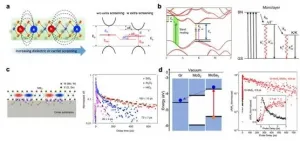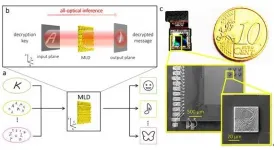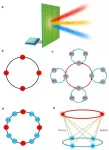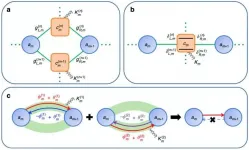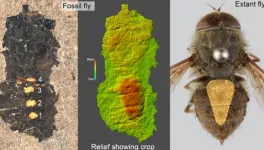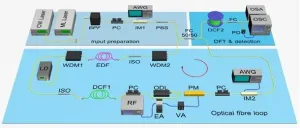(Press-News.org) Dietary and infant feeding guidelines should be strengthened to include more practical advice on the best ways to support children to learn to like and eat vegetables, say nutrition and dietetics researchers from the Flinders University Caring Futures Institute.
With the Australian Health Survey showing only 6% of children aged 2-17 years are eating the recommended amount of veggies, experts say more tailored practical advice is needed on how to offer vegetables to young children through repeated exposure and daily variety in order to increase their intake.
A recent paper co-authored by researchers from Caring Futures Institute and CSIRO, Australia's national science agency, published in the American Journal of Clinical Nutrition, suggests that up to 10 or more exposures to a particular vegetable when the child is between the age of 6 months and five years can lead to greater chances of them liking vegetables and eating more of them.
While the strategy of repeatedly exposing young children to vegetables to assist flavour familiarity and ultimately intake is not new science, there is a gap between evidence and dietary advice.
"There is an opportunity to improve children's vegetable intake by including practical advice - the 'how to' in our recommendations to parents and caregivers," says Flinders Caring Futures Institute Deputy Director and co-lead author of the paper Professor Rebecca Golley.
Prof Golley says food preferences are established within a child's first five years of life. Therefore, it's crucial to establish healthy eating behaviours early to support growth, development, and dietary habits.
"We know that a lack of vegetable consumption across the lifespan has effects on health, including an increased risk of chronic diseases, obesity and being overweight," she says.
"That is why getting children to like a variety of vegetables such as green beans, peas, carrots and even Brussel sprouts from an early age is so important.
"Early eating behaviours are impressionable and babies and young children can be supported to try different foods and to learn to like them."
The paper, Supporting strategies for enhancing vegetable liking in the early years of life: an Umbrella review of systematic reviews' is an output of the five-year VegKIT project, funded by Hort Innovation and undertaken by a consortium led by CSIRO, including Flinders University and Nutrition Australia Victoria Division.
An umbrella review was undertaken on the diverse body of existing international research around sensory and behavioural strategies that support children to like certain foods including vegetables.
The project examined 11 systemic reviews to determine the effectiveness of strategies including repeated exposure and variety of vegetables, for which promising evidence was found.
Emerging evidence was found for other strategies such as offering vegetables as a first food (not fruit), using non-food rewards to encourage the eating of veggies and reading children vegetable-based story books.
The report also highlights that foundations for vegetable liking can even be laid before a child is born.
"It appears that the maternal diet also plays a part through exposure to vegetable flavours in-utero and increasing children's chances of liking and eating them later, and the same goes for the mothers' diet while breastfeeding," Professor Golley says.
However, she says these strategies must be backed by more research if they are to be underpinning advice for parents, health professionals and policymakers.
INFORMATION:
Lucinda K Bell, Claire Gardner, Esther J Tian, Maeva O Cochet-Broch, Astrid A M Poelman, David N Cox, Sophie Nicklaus, Karen Matvienko-Sikar, Lynne A Daniels, Saravana Kumar, Rebecca K Golley, Supporting strategies for enhancing vegetable liking in the early years of life: an umbrella review of systematic reviews, The American Journal of Clinical Nutrition, 2021; DOI 10.1093/ajcn/nqaa384
Patients suffering from dry eye disease symptoms have a lower quality of life compared to those without symptoms, a new study reports. The findings showed that patients with the condition reported negative effects on visual function, their ability to carry out daily activities and their work productivity.
Dry eye disease is a common condition and a frequent reason for patients to seek medical care. It can affect people of any age but is most prevalent in women and in older people. Symptoms include irritation and redness in the eyes, blurred vision, and a sensation of grittiness or a foreign body in the eye. It has been reported that up to a third of adults over 65 years old have the condition, although the actual number is likely to be higher as there is no established ...
Two-dimensional (2D) semiconductors can host a rich set of excitonic species because of the greatly enhanced Coulomb interactions. The excitonic states can exhibit large oscillator strengths and strong light-matter interactions, and dominate the optical properties of 2D semiconductors. In addition, because of the low dimensionality, excitonic dynamics of 2D semiconductors can be more susceptible to various external stimuli, enriching the possible tailoring methods that can be exploited. Understanding the factors that can influence the dynamics of the optically-generated excited states represents an important aspect of excitonic physics in 2D ...
Today, machine learning based methods are of our everyday life, with millions of users every day unlocking their phones through facial recognition or passing through AI-enabled automated security checks at airports and train stations. Traditionally, the processing of information native to the optical domain is being executed in the electronic domain, requiring energy-hungry specialized electronic hardware and conversion between the two realms. Optical machine learning is emerging as an important field, where the processing of optical information is done directly within the optical domain, power-efficient and at the speed of light.
Machine learning tasks, such as pattern recognition or image classification, rely heavily on the multiplication of large matrices, a resource-hungry ...
Spatiotemporal metasurfaces, driven by ultrafast dynamic modulations, opened up new possibilities for manipulating the harmonic modes of electromagnetic waves and generations of exotic physical phenomena, such as dispersion cancellation, Lorentz reciprocity broken, and Doppler illusions. In recent years, rapid development of information technologies have stimulated many information processing applications for metasurfaces, including computational imaging, wireless communications, and performing mathematical operations. With increasing amount of researches focused on the topic of information processing ...
Optical nonreciprocity, which prohibits the light field returning along the original path after passing through the optical system in one direction, is not only of vast interest to fundamental science, which brings us a deeper understanding of Lorentz reciprocity, time-reversal symmetry, and topological effects, but is also of great importance for realizing nonreciprocal optical and electromagnetics devices such as isolators, circulator and directional amplifiers, which are indispensable for applications ranging from optical communication to optical information processing.
However, realizing nonreciprocity is rather difficult as it requires breaking of the Lorentz reciprocity ...
Looking at the night sky, one's thoughts might be drawn to astrochemistry. What molecules inhabit the vast spaces between the stars? Would we see the same molecules that surround us here on Earth? Or would some of them be more exotic--something rarely observed or even unknown?
Recent research by a multinational team led by Prof. Robert Ko?os from the Institute of Physical Chemistry of the Polish Academy of Sciences has revealed an unusual molecule obtained and detected for the first time in laboratory conditions and also paved a smooth path to produce and further study another. Now that they can be seen and studied, they may prove worthy ...
Until now, it was only possible to optimize an acoustic cloaking structure for the air-environment. However, with this latest research, Acoustic cloak designed by topology optimization for acoustic-elastic coupled systems, published in the latest Applied Physics Letters, it is possible to design an acoustic cloak for underwater environments.
In the conventional topology optimization of acoustic cloaking, the design method was based on an analysis that approximated an elastic body in the air as a rigid body. However, since the approximation holds only for materials that are sufficiently ...
Two types of materials are better than one when it comes to solar cells, as revealed by an international team that has tested a new combination of materials and architecture to improve solar-cell efficiency.
Silicon has long dominated as the premier material for solar cells, helped by its abundance as a raw material. However, perovskites, a class of hybrid organic-inorganic material, are a viable alternative due to their low-cost and large-scale manufacture and potentially higher performance. While still too unstable for full commercialization, they might become available to the market by 2022.
KAUST's Michele ...
It was not the fly itself that caught the scientists' attention, but its bulging abdomen suggesting it was still full with the fly's last food intake. Surprisingly, analysis of the stomach content revealed it was full with pollen from different plants. The fossil pollen from the fly's stomach was used to reconstruct the ancient environment inhabited by the fly, the biotic interactions between plant and fly, and the fly's behaviour during feeding.
Flies as pollinators
Today, bees, butterflies and bumblebees are the typical pollinators, which are also known to feed on pollen. That flies also play an important role in pollination ...
BOs describe the periodic movement of electrons in solids to which an external static electric field is applied. However, it is challenging to measure the BOs directly in natural solids since the relaxation time of electrons is usually much shorter than the oscillation period. To date, analogies of electron BOs have been extended to the synthetic dimensions of time, frequency and angular momenta. In previous studies, the frequency BOs have been experimentally demonstrated in a nonlinear fibre with cross-phase modulation. However, the frequency spectrum has ...

